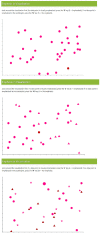Which emphasis technique to use? Perception of emphasis techniques with varying distractors, backgrounds, and visualization types
- PMID: 35177955
- PMCID: PMC8841630
- DOI: 10.1177/14738716211045354
Which emphasis technique to use? Perception of emphasis techniques with varying distractors, backgrounds, and visualization types
Abstract
Emphasis effects are visual changes that make data elements distinct from their surroundings. Designers may use computational saliency models to predict how a viewer's attention will be guided by a specific effect; however, although saliency models provide a foundational understanding of emphasis perception, they only cover specific visual effects in abstract conditions. To address these limitations, we carried out crowdsourced studies that evaluate emphasis perception in a wider range of conditions than previously studied. We varied effect magnitude, distractor number and type, background, and visualization type, and measured the perceived emphasis of 12 visual effects. Our results show that there are perceptual commonalities of emphasis across a wide range of environments, but also that there are limitations on perceptibility for some effects, dependent on a visualization's background or type. We developed a model of emphasis predictability based on simple scatterplots that can be extended to other viewing conditions. Our studies provide designers with new understanding of how viewers experience emphasis in realistic visualization settings.
Keywords: Data visualization; empirical evaluation; experimental studies; human-computer interaction; perception.
© The Author(s) 2021.
Figures


















References
-
- Segel E, Heer J. Narrative visualization: telling stories with data. IEEE Trans Vis Comput Graph 2010; 16(6): 1139–1148. - PubMed
-
- Bradbury JD, Guadagno RE. Documentary narrative visualization: features and modes of documentary film in narrative visualization. Inf Vis 2020; 19(4): 339–352.
-
- Healey CG, Enns JT. Attention and visual memory in visualization and computer graphics. IEEE Trans Vis Comput Graph 2012; 18(7): 1170–1188. - PubMed
-
- Gutwin C, Cockburn A, Coveney A. Peripheral popout: the influence of visual angle and stimulus intensity on popout effects. In: Proceedings of the 2017 CHI conference on human factors in computing systems, Denver, CO, 6–11 May 2011, pp.208–219. New York, NY: ACM.
-
- Treisman AM, Gelade G. A feature-integration theory of attention. Cogn Psychol 1980; 12(1): 97–136. - PubMed
LinkOut - more resources
Full Text Sources
